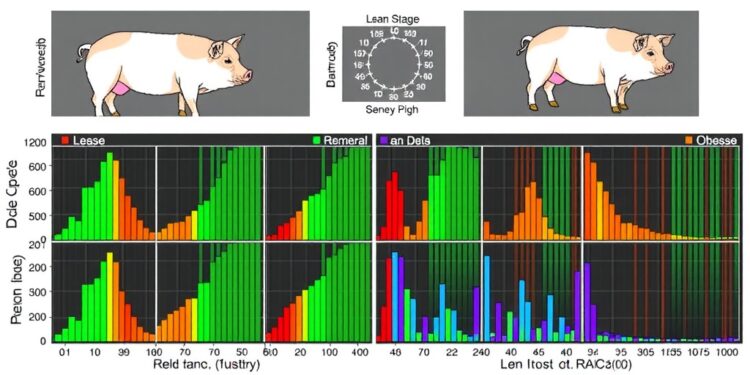
The intricate relationship between muscle and adipose tissues serves as a critical determinant of metabolic health and overall organismal wellness. This relationship, often referred to as the “muscle-adipose axis,” encompasses a complex network of secreted factors that facilitate communication between these two essential tissue types. Such interactions are not merely coincidental but are fundamental processes governing muscle differentiation, metabolic balance, and fat accumulation. Understanding these pathways offers valuable insights into the mechanisms underlying various metabolic disorders.
Recent studies have shed light on the Taoyuan Black pig, a Chinese native breed recognized for its unique metabolic traits. Unlike the lean Duroc pig, the Taoyuan Black pig demonstrates a higher intramuscular fat content and a greater proportion of slow-twitch muscle fibers. This breed is particularly prized for its superior meat quality, accompanied by a notable increase in peripheral fat deposition. The distinct characteristics of both Taoyuan Black and Duroc pigs make them exemplary models for investigating the dynamics of muscle-adipose tissue interactions and the etiology of metabolic diseases.
Cutting-edge research utilizing non-targeted metabolomics has unveiled pivotal insights into the longissimus dorsi muscle of Taoyuan Black pigs at various developmental stages. This analysis highlighted a critical “window period” for lipid accumulation and meat quality enhancement, occurring between 120 to 180 days of age. During this phase, the metabolic landscape of the muscle reveals significant variations influenced by both age and breed, focusing on key pathways relating to energy, lipid, amino acid, and protein metabolism.
The metabolomics and transcriptomics integrated approach illuminated specific differences between the muscle tissues of the two breeds, offering a fascinating glimpse into the biochemical basis of their distinct metabolic profiles. Among the plethora of identified metabolites at 180 days, several were found to correlate significantly with intramuscular fat content. Notably, organic acid metabolites such as fumaric acid, succinic acid, and malic acid exhibited a negative correlation with fat accumulation, highlighting their potential role in lipid metabolism regulation.
Conversely, certain lipid metabolites, including 2-Hydroxyisovaleric acid and carnitine, were positively correlated with intramuscular fat levels. These contrasting relationships between specific metabolites and fat content underline the complex metabolic interplay governing muscle and adipose tissue dynamics. Further investigation into these metabolites could pave the way for novel nutritional strategies aimed at enhancing meat quality and managing lipid deposition in livestock.
Focusing on the metabolites that mediate muscle-adipose tissue communication, this research provides a systematic examination of the metabolic differences between obese Taoyuan Black pigs and their lean counterparts. This exploration not only enhances our understanding of the physiological processes influencing meat quality but also opens avenues for the development of dietary additives and interventions aimed at optimizing lipid metabolism.
Moreover, the findings underscore the potential for utilizing pigs as animal models in metabolic disease research. Given their physiological and metabolic similarities to humans, pigs provide an invaluable resource for studying the intricacies of human metabolic disorders and the effects of various dietary interventions. The insights gleaned from this study can facilitate the design of effective strategies for managing obesity and related metabolic diseases in both livestock and humans.
As we delve deeper into the metabolic profiles of these distinct pig breeds, it becomes increasingly clear that the interplay between muscle and adipose tissues encompasses a wider spectrum of biological processes than previously understood. The identification of specific metabolites involved in muscle-adipose interactions not only enhances our comprehension of lipid deposition mechanisms but also raises critical questions about the long-term implications of metabolic dysregulation in livestock.
In conclusion, the research highlighting the muscle-adipose axis in the context of Taoyuan Black pigs sheds light on the pivotal roles these tissues play as metabolic and secretory organs. By unraveling the complex interactions that dictate muscle differentiation and fat accumulation, researchers stand on the cusp of advancing nutritional strategies that could significantly improve pork quality and address the broader challenges posed by metabolic diseases.
The advancement of our understanding in this area is vital, particularly as we seek to improve livestock production practices and combat rising rates of obesity and metabolic disorders worldwide. Continued exploration of the secretory factors that mediate tissue communication in the muscle-adipose axis will no doubt yield fruitful insights, potentially leading to groundbreaking strategies that enhance both animal welfare and human health outcomes.
The findings also serve to remind us of the interconnectedness of biological systems and the importance of a holistic approach to tackling metabolic disorders. By considering the complex relationships between different tissue types, along with their metabolic outputs, scientists can develop more comprehensive models for understanding and influencing metabolic health.
This research voyage into the metabolic world of Taoyuan Black pigs represents a step toward bridging the gap between animal science and human health. As science moves forward, the implications of these findings will echo beyond the barnyard, influencing nutritional practices and health strategies for both livestock and humans alike.
In essence, the Taoyuan Black pig serves as a beacon of hope and knowledge in the quest to decipher the mysteries of metabolic regulation and its profound impacts on quality and quantity of life. As the field of metabolomics expands, the promise of such research becomes ever more apparent, heralding new possibilities in the fight against metabolic diseases.
By harnessing the power of such biological insights, researchers can help reshape our understanding of nutrition and health, turning knowledge into action that benefits both livestock and the human populations that rely on them.
Subject of Research: Metabolic differences and muscle-adipose interactions in Taoyuan Black pigs
Article Title: Unraveling the Muscle-Adipose Axis: Insights from the Taoyuan Black Pig
News Publication Date: October 23, 2023
Web References: http://dx.doi.org/10.1007/s11427-024-2654-2
References: Science China Life Sciences
Image Credits: Not Applicable
Keywords: Muscle-adipose axis, Taoyuan Black pig, lipid deposition, metabolomics, metabolic diseases, meat quality, dietary interventions.
Tags: Developmental StagesDietary InterventionsIntramuscular Fat ContentLipid DepositionMeat QualityMetabolic DiseasesMetabolomicsMuscle-Adipose AxisOrganic Acid MetabolitesPorcine Metabolic ModelsTaoyuan Black PigTranscriptomics





